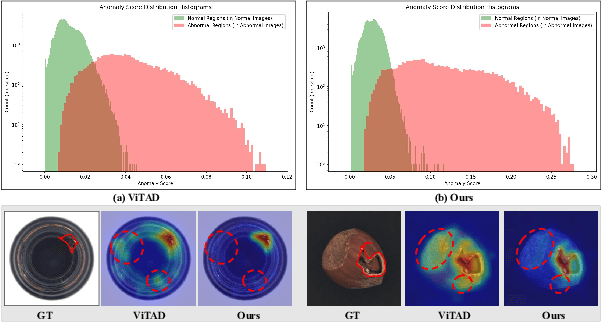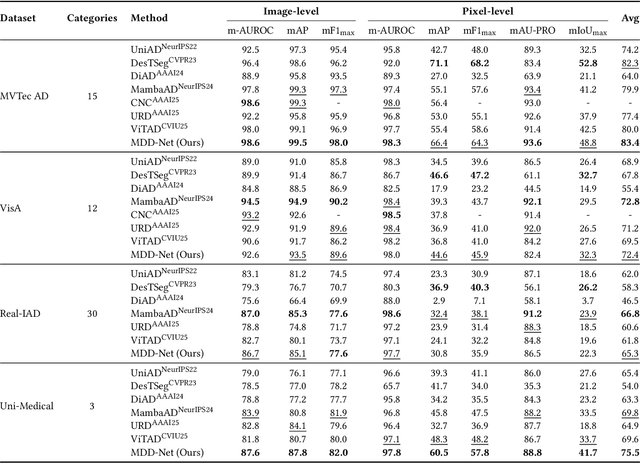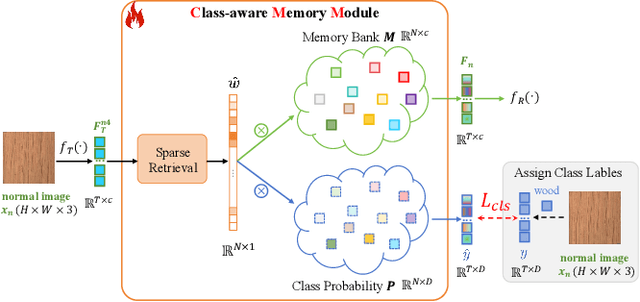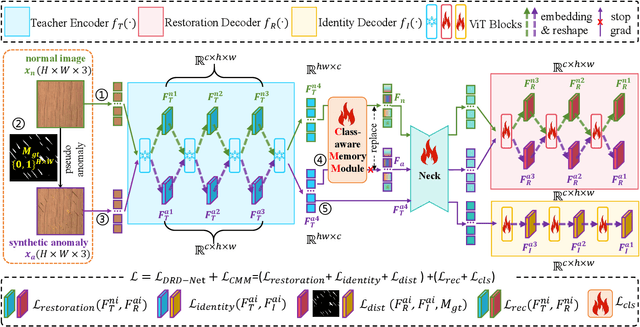Rong Xiao
UVLM: Benchmarking Video Language Model for Underwater World Understanding
Jul 03, 2025Abstract:Recently, the remarkable success of large language models (LLMs) has achieved a profound impact on the field of artificial intelligence. Numerous advanced works based on LLMs have been proposed and applied in various scenarios. Among them, video language models (VidLMs) are particularly widely used. However, existing works primarily focus on terrestrial scenarios, overlooking the highly demanding application needs of underwater observation. To overcome this gap, we introduce UVLM, an under water observation benchmark which is build through a collaborative approach combining human expertise and AI models. To ensure data quality, we have conducted in-depth considerations from multiple perspectives. First, to address the unique challenges of underwater environments, we selected videos that represent typical underwater challenges including light variations, water turbidity, and diverse viewing angles to construct the dataset. Second, to ensure data diversity, the dataset covers a wide range of frame rates, resolutions, 419 classes of marine animals, and various static plants and terrains. Next, for task diversity, we adopted a structured design where observation targets are categorized into two major classes: biological and environmental. Each category includes content observation and change/action observation, totaling 20 distinct task types. Finally, we designed several challenging evaluation metrics to enable quantitative comparison and analysis of different methods. Experiments on two representative VidLMs demonstrate that fine-tuning VidLMs on UVLM significantly improves underwater world understanding while also showing potential for slight improvements on existing in-air VidLM benchmarks, such as VideoMME and Perception text. The dataset and prompt engineering will be released publicly.
Language Embedding Meets Dynamic Graph: A New Exploration for Neural Architecture Representation Learning
Jun 09, 2025Abstract:Neural Architecture Representation Learning aims to transform network models into feature representations for predicting network attributes, playing a crucial role in deploying and designing networks for real-world applications. Recently, inspired by the success of transformers, transformer-based models integrated with Graph Neural Networks (GNNs) have achieved significant progress in representation learning. However, current methods still have some limitations. First, existing methods overlook hardware attribute information, which conflicts with the current trend of diversified deep learning hardware and limits the practical applicability of models. Second, current encoding approaches rely on static adjacency matrices to represent topological structures, failing to capture the structural differences between computational nodes, which ultimately compromises encoding effectiveness. In this paper, we introduce LeDG-Former, an innovative framework that addresses these limitations through the synergistic integration of language-based semantic embedding and dynamic graph representation learning. Specifically, inspired by large language models (LLMs), we propose a language embedding framework where both neural architectures and hardware platform specifications are projected into a unified semantic space through tokenization and LLM processing, enabling zero-shot prediction across different hardware platforms for the first time. Then, we propose a dynamic graph-based transformer for modeling neural architectures, resulting in improved neural architecture modeling performance. On the NNLQP benchmark, LeDG-Former surpasses previous methods, establishing a new SOTA while demonstrating the first successful cross-hardware latency prediction capability. Furthermore, our framework achieves superior performance on the cell-structured NAS-Bench-101 and NAS-Bench-201 datasets.
MiniMax-Remover: Taming Bad Noise Helps Video Object Removal
May 30, 2025Abstract:Recent advances in video diffusion models have driven rapid progress in video editing techniques. However, video object removal, a critical subtask of video editing, remains challenging due to issues such as hallucinated objects and visual artifacts. Furthermore, existing methods often rely on computationally expensive sampling procedures and classifier-free guidance (CFG), resulting in slow inference. To address these limitations, we propose MiniMax-Remover, a novel two-stage video object removal approach. Motivated by the observation that text condition is not best suited for this task, we simplify the pretrained video generation model by removing textual input and cross-attention layers, resulting in a more lightweight and efficient model architecture in the first stage. In the second stage, we distilled our remover on successful videos produced by the stage-1 model and curated by human annotators, using a minimax optimization strategy to further improve editing quality and inference speed. Specifically, the inner maximization identifies adversarial input noise ("bad noise") that makes failure removals, while the outer minimization step trains the model to generate high-quality removal results even under such challenging conditions. As a result, our method achieves a state-of-the-art video object removal results with as few as 6 sampling steps and doesn't rely on CFG, significantly improving inference efficiency. Extensive experiments demonstrate the effectiveness and superiority of MiniMax-Remover compared to existing methods. Codes and Videos are available at: https://minimax-remover.github.io.
Taming Transformer Without Using Learning Rate Warmup
May 28, 2025Abstract:Scaling Transformer to a large scale without using some technical tricks such as learning rate warump and using an obviously lower learning rate is an extremely challenging task, and is increasingly gaining more attention. In this paper, we provide a theoretical analysis for the process of training Transformer and reveal the rationale behind the model crash phenomenon in the training process, termed \textit{spectral energy concentration} of ${\bW_q}^{\top} \bW_k$, which is the reason for a malignant entropy collapse, where ${\bW_q}$ and $\bW_k$ are the projection matrices for the query and the key in Transformer, respectively. To remedy this problem, motivated by \textit{Weyl's Inequality}, we present a novel optimization strategy, \ie, making the weight updating in successive steps smooth -- if the ratio $\frac{\sigma_{1}(\nabla \bW_t)}{\sigma_{1}(\bW_{t-1})}$ is larger than a threshold, we will automatically bound the learning rate to a weighted multiple of $\frac{\sigma_{1}(\bW_{t-1})}{\sigma_{1}(\nabla \bW_t)}$, where $\nabla \bW_t$ is the updating quantity in step $t$. Such an optimization strategy can prevent spectral energy concentration to only a few directions, and thus can avoid malignant entropy collapse which will trigger the model crash. We conduct extensive experiments using ViT, Swin-Transformer and GPT, showing that our optimization strategy can effectively and stably train these Transformers without using learning rate warmup.
From Word to Sentence: A Large-Scale Multi-Instance Dataset for Open-Set Aerial Detection
May 06, 2025Abstract:In recent years, language-guided open-world aerial object detection has gained significant attention due to its better alignment with real-world application needs. However, due to limited datasets, most existing language-guided methods primarily focus on vocabulary, which fails to meet the demands of more fine-grained open-world detection. To address this limitation, we propose constructing a large-scale language-guided open-set aerial detection dataset, encompassing three levels of language guidance: from words to phrases, and ultimately to sentences. Centered around an open-source large vision-language model and integrating image-operation-based preprocessing with BERT-based postprocessing, we present the OS-W2S Label Engine, an automatic annotation pipeline capable of handling diverse scene annotations for aerial images. Using this label engine, we expand existing aerial detection datasets with rich textual annotations and construct a novel benchmark dataset, called Multi-instance Open-set Aerial Dataset (MI-OAD), addressing the limitations of current remote sensing grounding data and enabling effective open-set aerial detection. Specifically, MI-OAD contains 163,023 images and 2 million image-caption pairs, approximately 40 times larger than comparable datasets. We also employ state-of-the-art open-set methods from the natural image domain, trained on our proposed dataset, to validate the model's open-set detection capabilities. For instance, when trained on our dataset, Grounding DINO achieves improvements of 29.5 AP_{50} and 33.7 Recall@10 for sentence inputs under zero-shot transfer conditions. Both the dataset and the label engine will be released publicly.
Precision Neural Network Quantization via Learnable Adaptive Modules
Apr 24, 2025Abstract:Quantization Aware Training (QAT) is a neural network quantization technique that compresses model size and improves operational efficiency while effectively maintaining model performance. The paradigm of QAT is to introduce fake quantization operators during the training process, allowing the model to autonomously compensate for information loss caused by quantization. Making quantization parameters trainable can significantly improve the performance of QAT, but at the cost of compromising the flexibility during inference, especially when dealing with activation values with substantially different distributions. In this paper, we propose an effective learnable adaptive neural network quantization method, called Adaptive Step Size Quantization (ASQ), to resolve this conflict. Specifically, the proposed ASQ method first dynamically adjusts quantization scaling factors through a trained module capable of accommodating different activations. Then, to address the rigid resolution issue inherent in Power of Two (POT) quantization, we propose an efficient non-uniform quantization scheme. We utilize the Power Of Square root of Two (POST) as the basis for exponential quantization, effectively handling the bell-shaped distribution of neural network weights across various bit-widths while maintaining computational efficiency through a Look-Up Table method (LUT). Extensive experimental results demonstrate that the proposed ASQ method is superior to the state-of-the-art QAT approaches. Notably that the ASQ is even competitive compared to full precision baselines, with its 4-bit quantized ResNet34 model improving accuracy by 1.2\% on ImageNet.
SaENeRF: Suppressing Artifacts in Event-based Neural Radiance Fields
Apr 23, 2025Abstract:Event cameras are neuromorphic vision sensors that asynchronously capture changes in logarithmic brightness changes, offering significant advantages such as low latency, low power consumption, low bandwidth, and high dynamic range. While these characteristics make them ideal for high-speed scenarios, reconstructing geometrically consistent and photometrically accurate 3D representations from event data remains fundamentally challenging. Current event-based Neural Radiance Fields (NeRF) methods partially address these challenges but suffer from persistent artifacts caused by aggressive network learning in early stages and the inherent noise of event cameras. To overcome these limitations, we present SaENeRF, a novel self-supervised framework that effectively suppresses artifacts and enables 3D-consistent, dense, and photorealistic NeRF reconstruction of static scenes solely from event streams. Our approach normalizes predicted radiance variations based on accumulated event polarities, facilitating progressive and rapid learning for scene representation construction. Additionally, we introduce regularization losses specifically designed to suppress artifacts in regions where photometric changes fall below the event threshold and simultaneously enhance the light intensity difference of non-zero events, thereby improving the visual fidelity of the reconstructed scene. Extensive qualitative and quantitative experiments demonstrate that our method significantly reduces artifacts and achieves superior reconstruction quality compared to existing methods. The code is available at https://github.com/Mr-firework/SaENeRF.
Memory-Augmented Dual-Decoder Networks for Multi-Class Unsupervised Anomaly Detection
Apr 21, 2025



Abstract:Recent advances in unsupervised anomaly detection (UAD) have shifted from single-class to multi-class scenarios. In such complex contexts, the increasing pattern diversity has brought two challenges to reconstruction-based approaches: (1) over-generalization: anomalies that are subtle or share compositional similarities with normal patterns may be reconstructed with high fidelity, making them difficult to distinguish from normal instances; and (2) insufficient normality reconstruction: complex normal features, such as intricate textures or fine-grained structures, may not be faithfully reconstructed due to the model's limited representational capacity, resulting in false positives. Existing methods typically focus on addressing the former, which unintentionally exacerbate the latter, resulting in inadequate representation of intricate normal patterns. To concurrently address these two challenges, we propose a Memory-augmented Dual-Decoder Networks (MDD-Net). This network includes two critical components: a Dual-Decoder Reverse Distillation Network (DRD-Net) and a Class-aware Memory Module (CMM). Specifically, the DRD-Net incorporates a restoration decoder designed to recover normal features from synthetic abnormal inputs and an identity decoder to reconstruct features that maintain the anomalous semantics. By exploiting the discrepancy between features produced by two decoders, our approach refines anomaly scores beyond the conventional encoder-decoder comparison paradigm, effectively reducing false positives and enhancing localization accuracy. Furthermore, the CMM explicitly encodes and preserves class-specific normal prototypes, actively steering the network away from anomaly reconstruction. Comprehensive experimental results across several benchmarks demonstrate the superior performance of our MDD-Net framework over current SoTA approaches in multi-class UAD tasks.
EBAD-Gaussian: Event-driven Bundle Adjusted Deblur Gaussian Splatting
Apr 14, 2025Abstract:While 3D Gaussian Splatting (3D-GS) achieves photorealistic novel view synthesis, its performance degrades with motion blur. In scenarios with rapid motion or low-light conditions, existing RGB-based deblurring methods struggle to model camera pose and radiance changes during exposure, reducing reconstruction accuracy. Event cameras, capturing continuous brightness changes during exposure, can effectively assist in modeling motion blur and improving reconstruction quality. Therefore, we propose Event-driven Bundle Adjusted Deblur Gaussian Splatting (EBAD-Gaussian), which reconstructs sharp 3D Gaussians from event streams and severely blurred images. This method jointly learns the parameters of these Gaussians while recovering camera motion trajectories during exposure time. Specifically, we first construct a blur loss function by synthesizing multiple latent sharp images during the exposure time, minimizing the difference between real and synthesized blurred images. Then we use event stream to supervise the light intensity changes between latent sharp images at any time within the exposure period, supplementing the light intensity dynamic changes lost in RGB images. Furthermore, we optimize the latent sharp images at intermediate exposure times based on the event-based double integral (EDI) prior, applying consistency constraints to enhance the details and texture information of the reconstructed images. Extensive experiments on synthetic and real-world datasets show that EBAD-Gaussian can achieve high-quality 3D scene reconstruction under the condition of blurred images and event stream inputs.
Exploring a Principled Framework for Deep Subspace Clustering
Mar 21, 2025Abstract:Subspace clustering is a classical unsupervised learning task, built on a basic assumption that high-dimensional data can be approximated by a union of subspaces (UoS). Nevertheless, the real-world data are often deviating from the UoS assumption. To address this challenge, state-of-the-art deep subspace clustering algorithms attempt to jointly learn UoS representations and self-expressive coefficients. However, the general framework of the existing algorithms suffers from a catastrophic feature collapse and lacks a theoretical guarantee to learn desired UoS representation. In this paper, we present a Principled fRamewOrk for Deep Subspace Clustering (PRO-DSC), which is designed to learn structured representations and self-expressive coefficients in a unified manner. Specifically, in PRO-DSC, we incorporate an effective regularization on the learned representations into the self-expressive model, prove that the regularized self-expressive model is able to prevent feature space collapse, and demonstrate that the learned optimal representations under certain condition lie on a union of orthogonal subspaces. Moreover, we provide a scalable and efficient approach to implement our PRO-DSC and conduct extensive experiments to verify our theoretical findings and demonstrate the superior performance of our proposed deep subspace clustering approach. The code is available at https://github.com/mengxianghan123/PRO-DSC.
 Add to Chrome
Add to Chrome Add to Firefox
Add to Firefox Add to Edge
Add to Edge